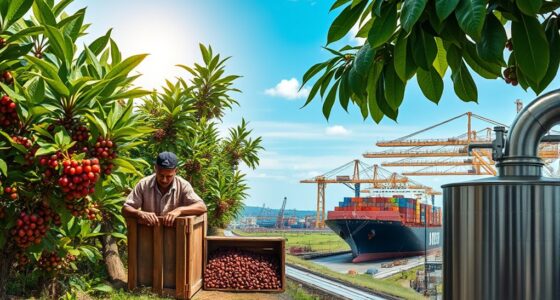Many coffee companies use advanced satellite imagery and geospatial tools to monitor deforestation in their supply chains. These tools provide high-resolution, real-time land use data, helping you detect early signs of forest loss and verify sustainable sourcing. By visualizing forest conditions in sourcing regions, companies stay transparent and assure compliance with environmental standards. If you’re interested in how these technologies enhance conservation efforts, you’ll discover more about their capabilities and benefits here.
Key Takeaways
- Satellite imagery provides high-resolution, real-time land use data to detect and monitor deforestation in coffee sourcing regions.
- These tools enable coffee companies to verify responsible sourcing and demonstrate transparency in supply chains.
- Deforestation mapping helps identify critical areas for reforestation and habitat restoration efforts.
- Companies use satellite data to ensure compliance with environmental regulations and international sustainability standards.
- Continuous monitoring supports informed decision-making and promotes sustainable land management practices.

Many coffee companies now rely on advanced deforestation mapping tools to track and reduce their environmental impact. These tools utilize satellite imagery, offering a bird’s-eye view of vast forested areas and enabling companies to monitor forest loss in real time. Satellite imagery provides high-resolution images that help identify signs of deforestation early, so you can respond quickly before the damage becomes irreversible. By analyzing these images regularly, you gain a clearer picture of how land use changes over time, making it easier to pinpoint areas at risk of deforestation due to agricultural expansion or illegal logging.
Using satellite imagery, you can detect subtle changes in forest cover that might otherwise go unnoticed. This technology helps you measure the extent of forest loss with great precision, allowing for more targeted conservation efforts. Instead of relying solely on on-the-ground reports, satellite data delivers extensive coverage, ensuring you don’t miss critical developments in remote or inaccessible regions. This continuous monitoring empowers you to take swift action, whether that means working with local communities, enforcing sustainable practices, or adjusting sourcing strategies to protect vulnerable ecosystems.
Satellite imagery enables precise detection of forest changes, supporting targeted conservation in remote, inaccessible regions.
Moreover, satellite imagery supports transparency and accountability in your supply chain. When you can visualize the state of forests where your coffee is sourced, you demonstrate a commitment to responsible sourcing practices. This transparency reassures consumers and stakeholders who are increasingly concerned about environmental impact. It also helps you comply with international regulations and sustainability standards, which often require proof of deforestation-free supply chains. Incorporating advanced technology like satellite imagery enhances your ability to meet these standards effectively.
The insights gained from satellite imagery also aid in planning reforestation projects and habitat restoration efforts. By accurately mapping forest loss, you can identify priority areas for conservation and track the success of your initiatives over time. This data-driven approach ensures your efforts are strategic and impactful, ultimately helping you reduce your overall environmental footprint.
Incorporating satellite imagery into your sustainability initiatives allows you to stay ahead of potential deforestation issues. You’re better equipped to make informed decisions, collaborate with local authorities, and implement policies that promote forest conservation. As a result, your company can maintain a reputation for ethical sourcing, contribute to global efforts against deforestation, and help preserve the ecosystems that coffee plants depend on. Staying vigilant with these advanced tools isn’t just good for the planet—it’s good for your business’s long-term sustainability.
Frequently Asked Questions
How Accurate Are Deforestation Mapping Tools for Coffee Plantations?
The accuracy of deforestation mapping tools for coffee plantations depends on satellite resolution and data verification. Higher satellite resolution provides more detailed images, making it easier to identify small-scale deforestation. However, data verification is vital to guarantee reliability, as false positives or negatives can occur. Overall, these tools are quite effective when combined with ground checks, but you should always consider their limitations for precise assessments.
Are These Tools Accessible to Small Coffee Farmers?
You might wonder if small farmers can access these advanced deforestation tools, and the answer is often no. Farmer accessibility remains limited due to technology barriers like high costs, lack of infrastructure, and technical know-how. This gap leaves many smallholders in the dark, unable to track or verify deforestation on their land. Without easier access, the fight against environmental damage becomes a challenge you need to confront.
How Often Are Deforestation Maps Updated by Companies?
You might wonder how often deforestation maps are updated. Typically, companies rely on satellite imagery, which is refreshed through data refresh cycles that can range from weekly to monthly, depending on the tool. This frequent updating helps guarantee accurate monitoring of forest changes. However, the exact refresh cycle varies by provider, so it’s good to check each tool’s specifications to understand how current the maps are.
Do These Tools Consider Illegal Deforestation Activities?
Illegal activities often slip through the cracks of deforestation mapping tools, making data accuracy a challenge. While these tools aim to identify clear-cut areas, they rarely detect covert illegal deforestation. As a result, companies may overlook illicit activities, risking misinformed decisions. You should understand that these tools have limitations, and monitoring illegal activities requires supplementary methods like on-the-ground inspections and local reports to guarantee exhaustive data.
Can Consumers Access Deforestation Data for Specific Coffee Brands?
Yes, you can access deforestation data for specific coffee brands. Many companies now prioritize supply chain transparency, making this information more available to consumers. By researching brands’ sustainability reports or using specialized platforms that track environmental impacts, you can boost your consumer awareness. This helps you make informed choices, supporting companies committed to reducing deforestation and promoting ethical sourcing practices in the coffee industry.
Conclusion
By understanding the deforestation mapping tools coffee companies use, you can see how they’re working to protect forests. For example, imagine a coffee brand using satellite data to identify illegal land clearing in real-time, preventing environmental damage before it worsens. With these technologies, you’re supporting companies that prioritize sustainability. Next time you sip your coffee, remember that innovative tools are helping preserve the forests for future generations, making your choice more impactful than ever.









